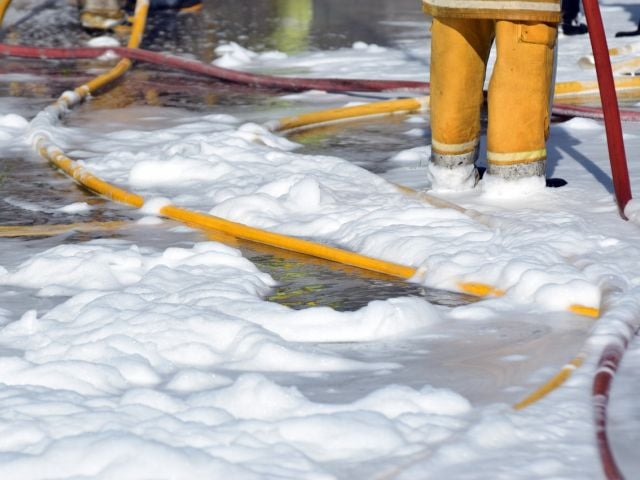WASHINGTON – The Defense Department is under fire for a new memo revealing it will prioritize providing clean drinking water only to communities polluted by the toxic “forever chemicals” at levels much higher than new federal limits.
To qualify for safer water, well owners must have a water supply three times more polluted than strict new federal PFAS drinking water limits allow.
The September 3 memo does not explain how or why the military chose the “three times” threshold. The decision lets the Pentagon off the hook for supplying, in a timely manner, as much safe water as it would need to if it followed the stricter limits. So it would not be obligated to give safe drinking water immediately to communities near dozens of bases in at least 21 states, where PFAS have been detected above the federal limits but below the three-times threshold.
“This is just another example of the DOD’s reluctance to clean up the PFAS mess they've made, even as service members and local communities suffer from contaminated drinking water and the health harms from exposure to these toxic chemicals,” said Jared Hayes, a senior policy analyst at the Environmental Working Group.
In April, the Environmental Protection Agency finalized new limits for six PFAS: PFOA, PFOS, GenX, PFBS, PFNA and PFHxS. These maximum contaminant levels are 4 parts per trillion, or ppt, for PFOA and PFOS and a hazard index for GenX, PFBS, PFNA and PFHxS. They are among the toughest health protections against PFAS in the world.
But the new military policy delays action until more research is done unless PFOA or PFOS levels exceed 12 ppt, at least 30 ppt for PFHxs, GenX and PFNA, or if they score a hazard index of at least 3.
“It's no surprise that the DOD is dragging its feet yet again,” said Hayes. “Its decision to delay action unless PFAS levels are three times higher than the EPA's limits is a predictable but disgraceful move.
“By ignoring the EPA’s science-based limits, the Pentagon is essentially saying that some level of contamination is tolerable. The military is gambling with the health and safety of countless Americans who rely on clean drinking water, and it's unacceptable,” added Hayes.
Widespread contamination
A total of 41 DOD bases in 21 states have off-base wells with detections above EPA standards but below the military’s cleanup commitment. They include Biddle Air National Guard Base, in Pennsylvania, KI Sawyer Air Force Base, in Michigan, and Oceana Naval Air Station, in Virginia.
While the DOD committed to eventually meeting the EPA's new standards as a cleanup goal, the department does not provide a timeline for starting to treat the wells with levels of PFAS that exceed the new maximum contaminant level. Households that rely on those wells will remain in limbo as they wait for their drinking water to be treated.
Across the country, many off-base wells near dozens of military sites are already contaminated with PFAS above the EPA’s new limits. These communities continue to wait for a long-overdue solution. And despite widespread PFAS pollution, only a small fraction of over 600 installations have tested the off-base wells for contamination.
It remains unclear if the DOD has told well owners with levels of PFAS above the new limit about the risks of exposure.
PFAS are known as forever chemicals because they build up in our bodies and never break down in the environment. The Centers for Disease Control and Prevention has detected PFAS in the blood of 99 percent of Americans, including newborn babies.
Very low doses of PFAS have been linked to suppression of the immune system. Studies show exposure to PFAS are linked to health harms including testicular, kidney, liver and pancreatic cancer; also harm fetal development, weakened childhood immunity; low birth weight; reduce vaccine effectiveness; endocrine disruption; increased cholesterol; and weight gain in children and dieting adults.
DOD delays on PFAS
The unjustified decision outlined in the DOD memo is yet another example of resistance to efforts by the Biden-Harris administration to address PFAS pollution across the country. The military has:
- Refused to comply with EPA orders to address contaminated drinking water in Tucson.
- Delayed phaseout of firefighting foam made with PFAS.
- Downplayed service members’ health concerns.
- Underfunded cleanup programs.
- Carried out interim cleanup actions at a small number of installations.
“Delaying action to clean up its PFAS contamination should no longer be an option. The Pentagon’s failure to act swiftly shows a disturbing lack of urgency and a blatant disregard for the health of our service members, their families and defense communities,” said Hayes.
“It’s time they prioritize the immediate cleanup of contaminated water and show real commitment to safeguarding those who have sacrificed so much for our country,” he added.
###
The Environmental Working Group is a nonprofit, non-partisan organization that empowers people to live healthier lives in a healthier environment. Through research, advocacy and unique education tools, EWG drives consumer choice and civic action.



